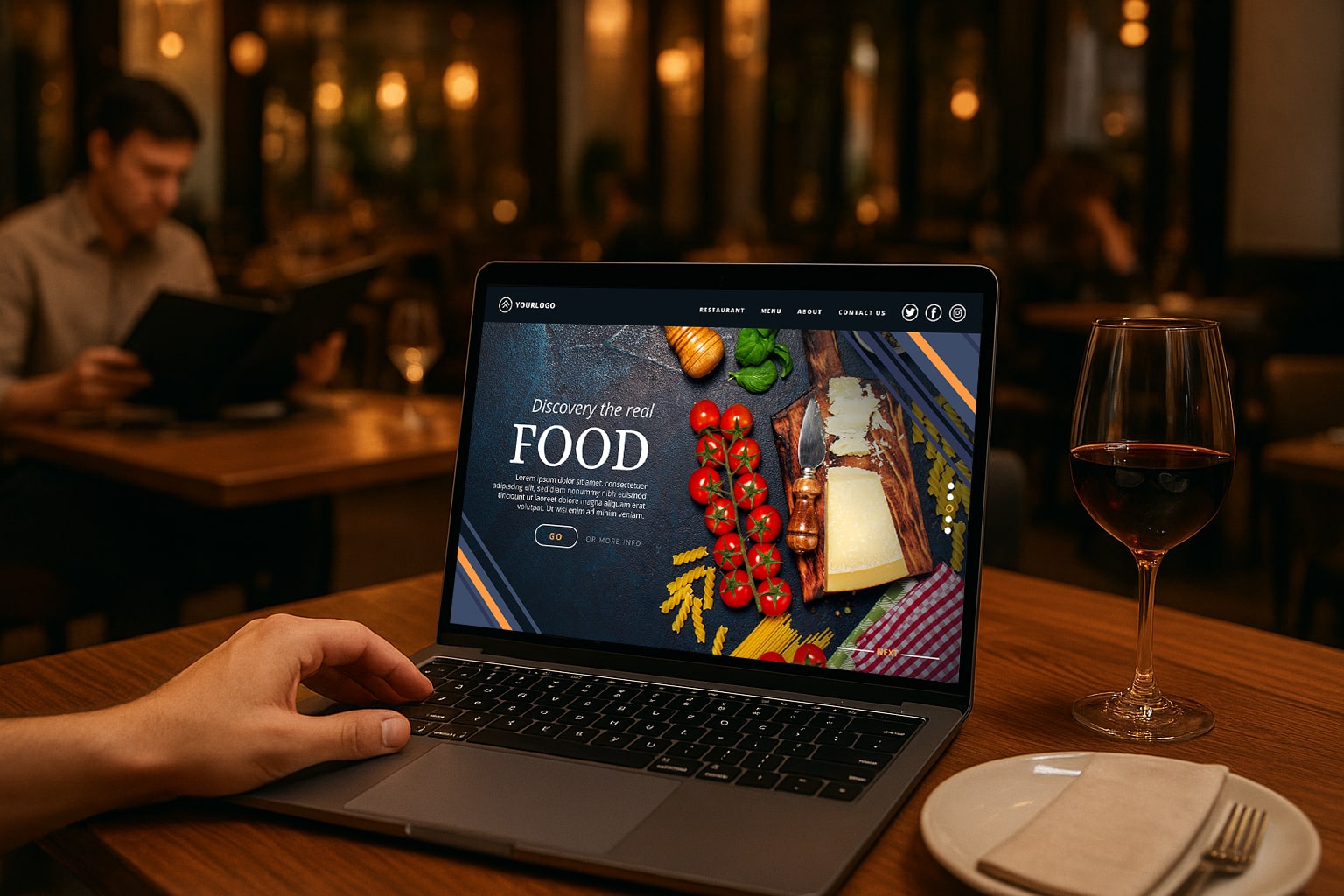Web Design Checklist for Healthcare, Restaurants, & Real Estate Agents
Your website is often the first impression potential clients have of your business. Whether you’re a healthcare provider treating patients, a restaurant serving diners, a physician building a practice, a family lawyer helping clients through difficult times, or a real estate agent selling homes, your website must work as hard as you do to attract, engage, and convert visitors into clients.
However, not all websites are created equal. Each industry has unique needs, regulatory requirements, and customer expectations that must be reflected in effective web design. A restaurant website needs to showcase menus and enable easy reservations, while healthcare web design must prioritize HIPAA compliance and patient portal integration. Real estate web design demands property search functionality that restaurant sites don’t need, and web design for family lawyer practices requires different trust signals than medical sites.
This comprehensive checklist walks you through the essential elements for creating effective websites across these five professional industries, highlighting both universal best practices and industry-specific requirements that separate average websites from exceptional ones that drive real business results.
Why Healthcare Web Design Demands a Patient-First Approach
Healthcare websites require a delicate balance between professionalism and approachability. Patients visiting your site are often anxious, seeking answers to pressing health concerns. Your design must immediately convey trust while making information accessible.
The foundation of effective healthcare web design starts with clear navigation. Patients should find appointment scheduling, insurance information, and service details within seconds of landing on your homepage. Implement prominent call-to-action buttons for scheduling appointments and accessing patient portals these aren’t just convenient features, they’re expectations in modern healthcare.
Your website must load quickly on smartphones, display beautifully on smaller screens, and make it effortless for users to find key information like your address, hours, and menu. If your site isn’t optimized for mobile, you’re not just losing potential customers—you’re actively driving them to your competitors.
HIPPA compliance
HIPAA compliance must guide every decision in your healthcare website development. Secure patient portals, encrypted contact forms, and privacy-focused design elements demonstrate your commitment to protecting sensitive information. Display your certifications and credentials prominently, but integrate them naturally into your design rather than overwhelming visitors with badges and seals.
Mobile optimization becomes critical when you consider that many patients search for healthcare providers during moments of concern or pain. A responsive design that loads quickly on smartphones ensures you’re accessible when patients need you most. Include easy-click phone numbers and map integration so patients can reach your office with minimal friction.
Restaurant Web Design That Makes Mouths Water and Phones Ring
Restaurant web design faces a unique challenge: your website must be as appetizing as your food. High-quality photography isn’t optional it’s the cornerstone of converting website visitors into dining room guests. Every image should be professionally shot, properly lit, and optimized for fast loading without sacrificing visual impact.
The menu is your restaurant’s most important webpage. It needs to be updated regularly, mobile-friendly, and easy to scan. Diners make decisions quickly, so organize your menu with clear categories, compelling descriptions, and accurate pricing. If you offer online ordering or reservations, these features should be impossible to miss.
Restaurant websites must balance atmosphere with functionality. Your design should reflect your restaurant’s personality, whether that’s upscale elegance, family-friendly warmth, or trendy excitement, while maintaining practical elements like directions, hours, and contact information. A reservation system integrated directly into your website eliminates friction in the booking process and reduces no-shows.
Social media integration amplifies your restaurant’s web design effectiveness. Embed your Instagram feed to showcase daily specials and create FOMO. Feature recent reviews from Google and Yelp to build social proof. Make sharing easy with well-placed social buttons that encourage diners to spread the word about their experiences.
Power of storytelling in restaurant web design
Don’t overlook the power of storytelling in restaurant websites. Share your origin story, introduce your chef, explain your sourcing philosophy, or highlight your commitment to the community. These narratives create emotional connections that transform first-time visitors into loyal regulars.
Real Estate Web Design That Showcases Properties and Expertise
Property presentation
Real estate web design centers on one critical element: property presentation. Your website is essentially a digital showroom, and every design decision should enhance how properties are discovered, explored, and remembered by potential buyers and sellers.
Advanced search functionality
Advanced search functionality separates good real estate websites from great ones. Implement filters for price range, location, property type, bedrooms, bathrooms, and amenities. Map-based search has become essential, allowing buyers to explore properties by neighborhood or school district. The search experience should be intuitive on both desktop and mobile devices.
Individual property listings deserve attention to detail. High-resolution photos, virtual tours, video walkthroughs, and drone footage create immersive experiences that help buyers fall in love with properties before stepping through the do
Lead capture mechanism
Lead capture mechanisms should be strategic, not aggressive. Offer property alerts for new listings matching buyer criteria, home valuation tools for potential sellers, and downloadable market reports. These value-driven incentives encourage visitors to share contact information without feeling pressured.
The Common Threads: Universal Design Principles for Service Industries
Before diving into industry-specific requirements, certain foundational elements are critical for any professional website, regardless of your field.
Mobile Responsiveness and Performance
Over 60% of web traffic now comes from mobile devices, making mobile optimization non-negotiable across all industries. Your website must function flawlessly on smartphones, tablets, and desktop computers.
✓ Mobile-Responsive Design: Your site automatically adapts to any screen size without horizontal scrolling, tiny text, or buttons too small to tap accurately.
✓ Fast Loading Speed: Pages load in under 3 seconds on both mobile and desktop. Use tools like Google PageSpeed Insights to test and identify improvement opportunities.
✓ Touch-Friendly Navigation: Buttons and links are large enough for finger taps (minimum 44×44 pixels) with adequate spacing to prevent accidental clicks.
✓ Optimized Images: All photos are compressed without visible quality loss, sized appropriately for web display, and use modern formats like WebP when possible.
✓ Readable Text: Font sizes are at least 16 pixels for body text, with good contrast between text and background colors for easy reading on any device
Clear Contact Information
Making it easy for potential clients to reach you seems obvious, yet countless professional websites bury contact information or require multiple clicks to find it.
✓ Prominent Phone Number: Display your phone number in the header of every page, making it clickable on mobile devices for one-tap calling.
✓ Complete Address: Show your full physical address if clients visit in person, not just city and state.
✓ Multiple Contact Methods: Offer phone, email, contact forms, and consider live chat or text messaging options to accommodate different communication preferences.
✓ Business Hours: Clearly display when you’re available, including any variations by day and special holiday hours.
✓ Emergency Contact: For service-based businesses like healthcare or legal practices, provide after-hours emergency contact information if applicable.
Professional Visual Design
Your website’s appearance immediately communicates professionalism and credibility—or the lack thereof.
✓ Clean, Modern Layout: Avoid cluttered designs with too much competing information. White space improves readability and guides attention to important elements.
✓ Consistent Branding: Use colors, fonts, and design elements consistent with your business branding across all marketing materials.
✓ High-Quality Photography: Use professional photos of your actual business, team, and work not generic stock images that undermine authenticity.
✓ Readable Typography: Choose professional fonts appropriate for your industry. Limit yourself to 2-3 fonts maximum throughout your site.
✓ Strategic Color Use: Select colors that reflect your brand while ensuring adequate contrast for readability and accessibility.
Security and Trust Signals
Website security isn’t just a technical requirement it’s visible trust signal that influences whether visitors feel comfortable sharing information with you.
✓ SSL Certificate: Ensure your site uses HTTPS (look for the padlock icon in browsers) to encrypt data transmission and meet modern security standards.
✓ Privacy Policy: Include a comprehensive privacy policy explaining how you collect, use, and protect visitor information.
✓ Security Badges: Display relevant security certifications, especially near forms where visitors submit personal information.
✓ Professional Affiliations: Showcase memberships in industry associations, certifications, and licenses that demonstrate credibility.
✓ Trust Indicators: Include Better Business Bureau ratings, professional certifications, awards, or other third-party validations of your expertise.
Search Engine Optimization Foundation
Even beautiful, functional websites fail if potential clients can’t find them. Basic SEO ensures your site appears when people search for services you provide.
✓ Descriptive Page Titles: Each page has a unique, descriptive title including relevant keywords (e.g., “Emergency Dental Care | [Your Practice Name]”).
✓ Meta Descriptions: Write compelling descriptions for each page that appear in search results and encourage clicks.
✓ Header Structure: Use proper heading hierarchy (H1, H2, H3) to organize content and help search engines understand page structure.
✓ Image Alt Text: Add descriptive alt text to all images for accessibility and SEO benefits.
✓ Fast Loading Speed: Page speed is a confirmed Google ranking factor—slow sites rank lower than fast competitors.
✓ Mobile-Friendly Design: Google prioritizes mobile-friendly sites in search results, making responsive design essential for SEO.
Your website is never truly finished it’s a living tool that should evolve with your business and respond to client needs. Whether you’re focused on healthcare web design, perfecting your restaurant’s online presence, developing web design for family lawyer practices, optimizing General Physician Web Design in Indianapolis requires, or enhancing your real estate web design, the principles remain consistent: put your audience first, make information accessible, build trust through transparency, and remove barriers between potential clients and your services.
The investment in professional web design pays dividends through increased visibility, higher conversion rates, and stronger client relationships. Your website works around the clock, representing your business when you can’t be there personally. Make it count.
Don’t let an outdated or ineffective website hold your business back. Whether you’re in healthcare, hospitality, legal services, or real estate, we specialize in creating industry-specific websites that convert visitors into loyal clients.







